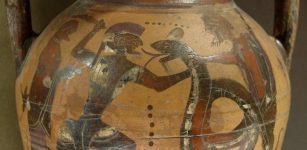Ancient Romans Used The Poisonous Black Henbane Plant As Hallucinogenic Medicine
Jan Bartek - AncientPages.com - In ancient times, the black henbane plant was as fascinating as feared. Ancient physicians knew that when administered in appropriate quantities, this toxic flora served as a gentle narcotic, possessing the ability to alleviate pain. However, ingesting too much of it could result in madness.
"It makes people crazy and generates very horrible dreams, therefore is considered dangerous to use," Pedanius Dioscorides (40–90 AD), Greek physician, pharmacologist, botanist, and author of De materia medical, wrote.
Black Henbane plant. Credit: Adobe Stock - emilio100
While examining 86,000 animal bones found at a 2000-year-old farmstead at the Roman-period settlement of Houten-Castellum in the Netherlands, archaeozoologist Maaike Groot of the Free University of Berlin and her colleague Martijn van Haasteren, an archaeozoologist now working for the Cultural Heritage Agency of the Netherlands did not pay attention to the fact that one of these bones was sealed at one end by a small birch tar plug. When van Haastersen accidentally dislodged it, hundreds of tiny black specks spilled out.
The examination of the seed verified that the seeds discovered within a hollow bone were those of the black henbane.
It is the first firm evidence that the Romans intentionally gathered and utilized the toxic seeds of the black henbane plant.
The team's findings support the accounts of classical writers such as Pliny the Elder, who discuss the plant's medical applications as a treatment for various health issues such as fever, cough and pain.
The bone cylinder and plug (reproduced from Groot & van Haasteren, 2017: fig. 14.14B); B) black henbane seeds (photograph by BIAX Consult). Credit: Antiquity (2024). DOI: 10.15184/aqy.2024.5
Our results indicate that Roman medical practices even extended to rural communities on the Empire's periphery," Groot explains.
Prior studies suggest that the bone might have been used as a pipe for smoking henbane, given the seeds' known capacity to induce hallucinogenic experiences. However, no evidence of charring was found on these seeds or any signs of burning on the pipe.
Ancient Romans. Credit: Adobe Stock - Archivist
Moreover, inhaling smoke from hundreds of such seeds contained within the pipe could potentially be lethal, which implies it was instead a container for storing the seeds rather than a smoking device.
See also: More Archaeology News
The discovery of black henbane by archaeologists in north-western Europe has been a rare occurrence, with only four instances indicating intentional use. Among these, just one instance from medieval Denmark involved finding the plant in a container. However, Groot and her team have made an unprecedented breakthrough by discovering black henbane seeds within a Roman period container for the first time.
This study significantly contributes to the ongoing discourse on differentiating between weeds and cultivated plants within archaeological contexts.
Written by Jan Bartek - AncientPages.com Staff Writer























